






















Your specialist for medical devices in the eld of tracheostomy & laryngectomy
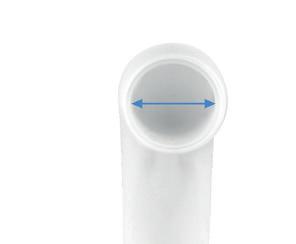



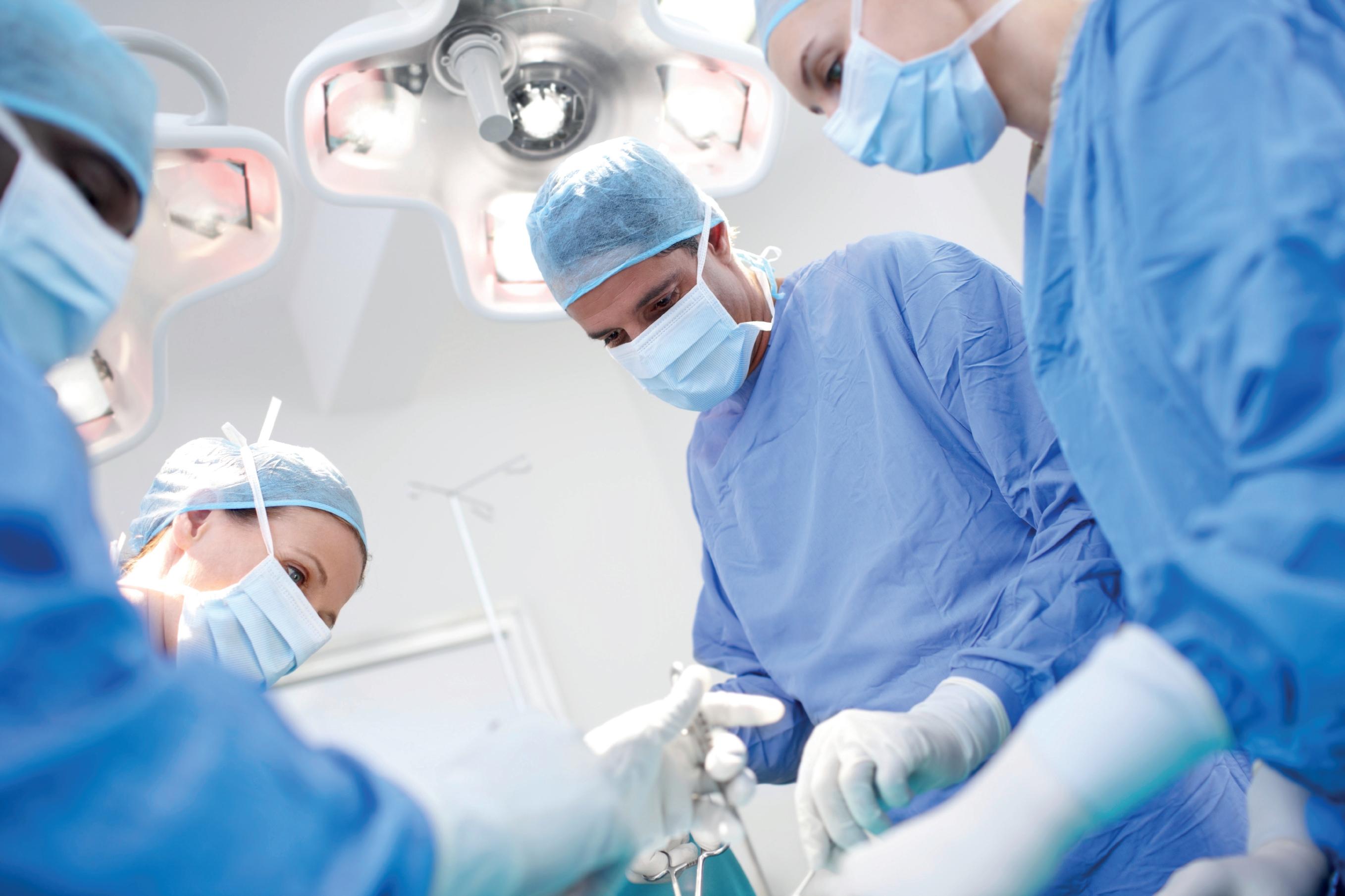
Tracheostomy tubes with an excellent realtionship between inner and outer diameter

Thin-walled design for generous air supply
Made of tissue-friendly polyurethane (PU)
Ultra-thin polyurethane low-pressure cuff which helps to prevent microaspiration (for cuffed versions)
Swivelling 15 mm connector on all inner cannulas
Secure bayonet catch
Available with speaking option
Available with subglottic suction function (suction line perfectly embedded into tube wall)
Available in standard and extended length
Halberstadt
M edizintechnik GmbH
Straße des 20. Juli 1
D - 38820 Halberstadt
Tel. 0049 (0) 3941 - 668 6
Fax. 0049 (0) 3941 - 245 65
www.primed-halberstadt.de primed@primed-halberstadt.de









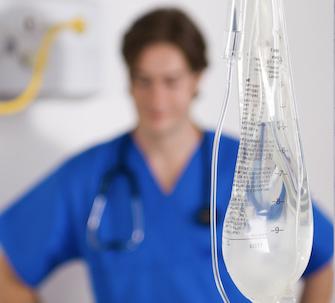






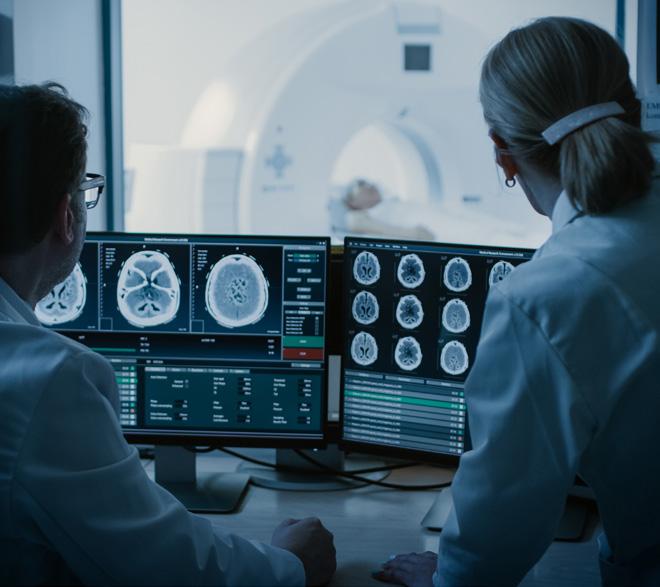





Chancellor Jeremy Hunt has announced in the ‘Budget for Long Term Growth’ that the NHS in England will receive a £2.5 billion day-to-day funding boost.
They have also given the NHS £3.4 billion in capital investment over the forecast period to help unlock £35 billion in productivity savings over the next Parliament.
This will be done by improving new technology, like making the NHS app a single front door for patients, piloting new AI to halve form-filling times for doctors, rolling out universal electronic patient records, and upgrading over 100 AI-fitted scanners so doctors can read MRI scans more accurately and quickly.
It is part of the Public Sector Productivity Plan to deliver better public services.
As well as this, Hunt has announced a new tax on the liquid in vapes.
It will introduce a levy for products containing more nicotine, and will come into effect in October 2026.



The annual British Social Attitudes survey has revealed that satisfaction with the NHS is at the lowest level recorded since the survey began in 1983. This is the case across every service and within all demographics and socio-economic groups.
The report based on the British Social Attitudes survey explores public satisfaction with the NHS and social care. The report assesses how views towards the NHS and social care have changed over time and public opinion on NHS priorities and funding in the context of prominent national debate about taxation and healthcare spending.
In 2023, fewer than 1 in 4 (24 per cent of people) were satisfied with the NHS, which is a drop of 29 percentage points since 2020.
The main reasons for discontent were GP and hospital appointment waiting times (71 per cent), staff shortages (54 per cent), and insufficient government spending (47 per cent).
Satisfaction with GP services and NHS dentistry were the biggest drops, falling to record lows of 34 per cent and 24 per cent respectively. Inpatient and outpatient were the highest-rated NHS services.
84 per cent of respondents believed that the NHS has a major or severe funding problem, and when asked about government choices on tax and NHS spending, most chose to increase taxes and spend more on the NHS (48 per cent).
Respondents said that the most important priorities for the NHS were ‘making it easier to get a GP appointment’ (52 per cent) and ‘increasing the number of staff in the NHS’ ...





Since its launch 18 months ago, more than 1 million patients have used the national online service to register with a GP.
The online Register with a GP surgery service, which is managed by NHS England, enables patients to go online at any time of day to find and register with a local GP. This means they don’t have to visit the practice in person.
One in three GP practices now offer the service, which was introduced to make registering with a new GP simpler and more convenient for both patients and GP practices.
The latest figures show almost half (48 per cent) of patients registered outside normal GP surgery opening hours and one in 15 accessed the digital service in another language.
In the recently published GP contract, all GP surgeries in England have been asked to offer the Register with a GP surgery service from October 2024.
Dr Amanda Doyle, national director of primary care and community services for NHS England, said: “We’re delighted to have reached this milestone of 1 million GP registration forms submitted online in the last 18 months, which shows the value of the service for both patients and GP surgeries.
“The service not only reduces the administrative burden for general practice, but also makes GP registration much more accessible to the public – offering patients more choice, convenience and consistency.
“We continue to see a steady increase in the number of GP practices coming on board...



The NHS is set to roll out artificial intelligence (AI) to reduce the number of missed appointments and free up staff time.
The use of the technology will expand to ten more NHS Trusts following a pilot in Mid and South Essex NHS Foundation Trust, which saw the number of did not attends (DNAs) reduced to almost a third in six months.
The software predicts likely missed appointments through algorithms and anonymised data, breaking down the reasons why someone may not attend an appointment using a range of external insights including the weather, traffic, and jobs, and offers back-up bookings.
The appointments are then arranged for the most convenient time for patients. For example, it will give evening and weekend slots to those less able to take time off during the day.
The system also implements back-up bookings in a bid to ensure no clinical time is lost while maximising efficiency.
Dr Vin Diwakar, national director for transformation at NHS England, said: “The NHS has long been a pioneer of innovation, embracing new ways of working so patients get the help they need in a timely way, and the use of AI to help reduce the number of missed appointments is another example of how new technologies are helping to improve care for patients.”
He said: “Not only can these technologies help to free up doctors’ time to treat more patients and reduce waiting times for planned care ...


The healthcare requirements in the UK are becoming increasingly complex each year, necessitating the recruitment of additional healthcare professionals to ensure smooth operations in specific areas of the healthcare system.
If you are a qualified doctor, nurse, health professional, or adult social care professional, you may meet the eligibility criteria to apply for the Health and Care Worker Visa.
Holmes & Partners provides a full end-to-end visa application service to companies, educational institutions and individuals.
We are based in Leeds, UK and is here to support applicants with the increasingly complex visa application process.








Fixed price fee
Full end-to-end visa application assistance and advice
Contact you directly with clear instructions
through every step of the visa application process
Check all documents to ensure UKVI documentary compliance
Complete the visa application on your behalf
Confirm successful visa outcome
Act on your behalf with UKVI decision makers
Answer any follow up questions

https://holmes-partners.co.uk/services/individuals/health-and-care-worker-visa/


In a world where sustainability and going green are among the top priorities for organisations, going digital is the best way forward

Digitising cleaning audits provides users the opportunity to identify trends and hot spots. It also offers greater transparency and a more effective way to share data within an organisation.
The introduction of the National Standards of Healthcare Cleanliness (NSoHC) 2021, saw the NHS move to digital cleaning audit tools. However, other workplace environments still use paper-based cleaning audit checklists that are completed by cleaning companies and janitorial staff to demonstrate that cleaning compliance standards are met.
Asckey’s fmfirst Cleaning audit tool is specifically designed to help healthcare organisations meet the NSoHC 2021 compliance requirements. The standards seek to drive improvements while being flexible enough to meet the complex requirements of all healthcare organisations. The software mirrors this principle.
On completing the audits, the application automates report emails and includes any required corrective actions. This method of providing instant fault reporting and rectifying options allows users to act right away, allowing time and resources to be proportionately allocated. Information can be displayed in a variety of different colour-coded dashboards. Outside of the NHS, cleaning audit software can be too complex.
This is where survey audit tools can help to digitally collect the data to demonstrate compliance standards are being met across any industry.
Asckey’s fmfirst Survey is a more tailored application that can provide a digital audit trail of completed tasks, prove compliance standards are being met, and identify possible risk areas. The application can support a variety of survey types, such as efficacy audits, fire risk assessments, the Premises Assurance Model, and user feedback. The data can be displayed in different formatted tables and charts that identify key information and trends in the data.
Investing in an application that can integrate with other programmes used by an organisation can strengthen your facilities management toolkit. Time is short, and budgets are tight, which is why Asckey has developed its FM applications to be modular. It provides facilities managers with a flexible and affordable system that can grow and meet the demands of their organisation.
However, it’s important not just to invest in the software but also the client care. The support function of the software purchased can be just as important as the product itself.
Our FM software is all about helping you to deliver an efficient and effective service that people can trust, so it’s only right that behind the product, our company is based on the same ethos. M
Asckey Data Services Ltd www.asckey.com


The NHS has been going through turbulent times. Following the unparalleled crisis caused by the covid pandemic and battling to reduce the subsequent hospital waiting times, healthcare professionals now have another pressing emergency to overcome. Jackie Maginnis, chief executive of the Modular and Portable Building Association (MPBA) discusses how modular building technology is helping alleviate the potential disruption caused by the reinforced aerated autoclaved concrete (RAAC) issue
The NHS has a long association with modular building techniques and for decades, advanced modern methods of construction (MMC) have been used to rapidly deliver much needed operating theatres, birthing units, diagnostic centres, wards, administration buildings and during the pandemic – urgent care and testing facilities.
RAAC in hospitals and other healthcare buildings poses a risk to staff and patients. It is a material that was widely used in the
construction of public buildings from the 1950s to 1990s. The use of RAAC led to the closure of just under 150 schools across England and was found to be a risk to hospitals, housing blocks and other public buildings.
RAAC is a lightweight precast concrete material with air bubbles formed inside due to the autoclaving process. RAAC was widely used as a building material because it is cheap, lightweight and provides good thermal insulation. However, there are several E
Reduce your carbon footprint this winter with the best eco-friendly ice melt for public areas

www.ecogrit.co.uk



EcoGrit Concentrate Also available in 20 kilo bags & 20 Kilo buckets
F structural deficiencies associated with it including cracking, excessive displacements and durability.
The Government reports that 42 NHS sites have been confirmed to have RAAC plank construction and through the national remediation programme, RAAC has been eradicated in three of these sites. In most identified cases, RAAC has been found in limited parts of a building, however seven of these hospitals need a full replacement and will be rebuilt through the New Hospital Programme (NHP) before 2030 and this is where volumetric modular construction comes to the fore.
It is widely acknowledged that modular technology can not only provide temporary portable buildings to alleviate the immediate crisis but also factory manufactured volumetric buildings will provide the most cost-effective and time-efficient long-term solution to the RAAC crisis.
Currently healthcare specialists within our membership are stepping up to support the NHS as they did at the time of the Covid pandemic – both those hiring portable buildings and experts in the field of manufacturing modules specifically for the healthcare sector.
It is now established that a volumetric modular approach is a game changer for the healthcare construction industry – reducing build times whilst increasing quality, productivity and safety.
Pre-Manufactured Value (PMV) is another driving force in the specification of volumetric technology in the sector. PMV is a core metric for measuring the level of MMC in a project and is central to the UK Government’s NHS procurement programmes. To secure a contract, suppliers are required to show that pre-manufacturing in quality-controlled factory environments will account for 70 per cent of their construction cost, which plays to the strengths of a volumetric modular approach.


It is now established that a volumetric modular approach is a game changer for the healthcare construction industry
Bringing a manufacturing mindset to the design and construction of healthcare facilities – with volumetric buildings, all construction data can be validated and coordinated as part of a structured process, which helps provide accurate and reliable information for clients at the point of handover. Volumetric construction helps ensure client satisfaction and offers product assurances through the certainty and quality embedded into the manufacturing process.
Not only is the actual construction of modular buildings ‘greener’, but importantly in these times of excessive heating costs, volumetric manufactured buildings are more energy efficient. Through superior insulation and achieving enhanced levels of airtightness – primary energy requirements and in-use operational emissions are reduced throughout the lifetime of the building. The emphasis with net zero construction is quite rightly focused on the environment but through a more sustainable approach to designing and developing buildings, those operating in the healthcare sector will reap the benefits for many generations to come.
There is significant evidence that traditionally constructed buildings do not produce structures that perform as well as design expectations and there is a great void between anticipated and actual in-use performance. Findings from studies such as PROBE (Post-occupancy Review Of Buildings and their Engineering) reveal that actual energy consumption in buildings is often as much as twice of that predicted at the design stage. E

Prevent everyday wear and tear with Yeoman Shield’s extensive range of easy-clean, wall and door protection.
Our attractive, maintenance free, hygienic products protect healthcare environments from costly impact damage, making repainting and repair a thing of the past.
Blending with decors, and available in primary dementia-friendly colours, our designs can include signage, to promote the well-being of patients and aid wayfinding.
For more information call 0113 279 5854 or email info@yeomanshield.com
MAINTENANCE FREE means cost effective wall and door protection www.yeomanshield.com
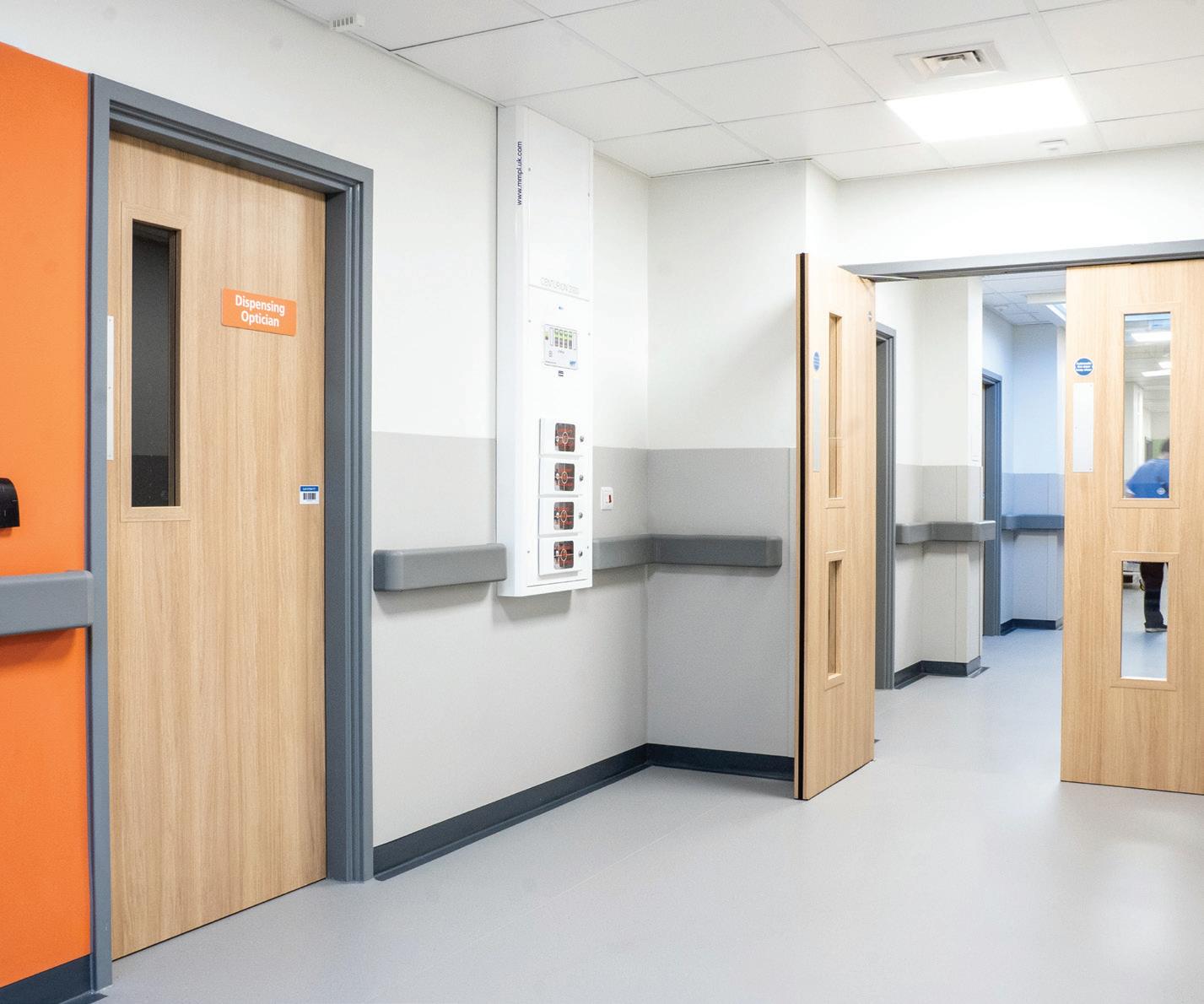

F At the forefront of offsite approaches, it is now established that volumetric modular technology is a game changer for the construction industry – reducing build times by an impressive 50-60 per cent whilst increasing quality, productivity and safety.
Factory manufactured modular buildings are highly accurate, well insulated and airtight, with air permeability of 1.5-3 m3 @50PA being the norm. A key advantage of modular construction is the quality benefits which come from working in a controlled environment. By producing buildings in a factory setting, the quality of elements such as insulation can be better assured.
This manufacturing method also allows better control over optimising material use. The surplus materials are recycled or reused for future projects, reducing construction waste that ends up in landfill. Materials are protected from moisture and extreme weather conditions, reducing the risk of disposal through water ingress and damage. It is widely recognised that modular has the potential to reduce overall construction programmes, but it is not often acknowledged this approach can reduce up to 90 per cent of the waste generated when compared with traditional construction methods.
Providing a predictable pathway for NHS builds, the benefits of volumetric manufactured buildings begin in the factory, continue to the construction site and last through the lifetime of the building.
The Modular and Portable Building Association plays a key role in supporting all sections of the
The surplus materials are recycled or reused for future projects, reducing construction waste that ends up in landfill
industry. Leading best practice principles, the association is represented on many committees for the benefit of members.
Many MPBA members are accredited under a number of modular building frameworks, including NHS Shared Business Services Framework, LHC, Crown Commercial Service, NHS Commercial Solutions and the Modular Buildings Framework. These frameworks help NHS trusts and other public sector clients improve the speed and cost-efficiency of procurement to support world-class patient care. Given the time-critical nature of this crisis, the need to quickly source modern and fully functional buildings is imperative. The MPBA is keen to help and by putting calls out to their extensive network, they can save NHS Estate Managers and leaders valuable time and resources. L
Those involved in the procurement of healthcare facilities can gain help to quickly engage with portable building providers or modular manufacturers by calling Jackie Maginnis, Chief Executive of the MPBA on 024 7590 1938, emailing: mpba@mpba.biz or visiting: www.mpba.biz


Carbon3 specialises in the design, installation and ongoing maintenance of medium to large Solar PV systems on public and commercial buildings. Talk to us today to find out how we can help utilise your roof space to reduce energy bills and lower CO2 emissions.
Free Survey and Feasibility Report
Experience in delivering projects on high profile buildings with complex requirements
Fully Funded Options: Start saving immediately with no installation costs
Ongoing Support: Full O&M Service including Remote Monitoring and Fault Alerts


EV Charging: Installation and Ongoing Management
0300 303 5688
www.carbon3.co.uk



In Partnership with City of Wolverhampton Council, the Royal Wolverhampton NHS Trust (RWT) has built a solar farm the size of 22 football pitches at a former landfill site
The facility, which is set to open in April, will power the entire New Cross Hospital site with self-generated renewable energy for around 288 days a year (around three quarters of the year).
It is hoped the development will save the Trust around £15-20 million over the next 20 years – and that the money saved can be reinvested into frontline healthcare.
The site will produce 6.9MWp of renewable energy for New Cross Hospital and will generate an estimated carbon saving of 1,583 tonnes of CO2e per annum.
The site was previously mined for coal and operated as a landfill until 1996, when it was closed and capped. The Environment Agency has regulated the site since then and ensured monitoring and maintenance of the site is managed in accordance with its environmental permit.
According to the council , the unused site, adjacent to an industrial site, had experienced anti-social behaviour and fly-tipping.
Joe Craddock, environment officer at the Environment Agency said: “It’s fantastic to see a former landfill being used in this way to provide a renewable energy source for the hospital.
“We have taken the opportunity of working with the council to not only maintain but also improve the infrastructure of the closed landfill. We have required City of Wolverhampton Council to review and improve the leachate and gas wells on the site and make updates to the gas flare.
“We will continue to monitor and manage the site as it changes its use into a new source of renewable energy.”
Before construction of the farm, work was undertaken to protect badger setts and remove methane. Now, more than 15,000 electricity generating solar panels have been installed at the site.
It is hoped that the project, along with other green technologies, will help the trust to move away from reliance on the national grid and E
Decentralised generation and supply of electricity and heat for operation with natural gas, biogas, other lean gases, biomethane, and hydrogen.
Increase profit
Save energy costs
Increase on-site resilience
Full turnkey solutions
Power range between 20 and 4,500 kW
Containerised solutions to reduce noise
Full-service solutions

Buy your CHP today, have it converted to H2 tomorrow
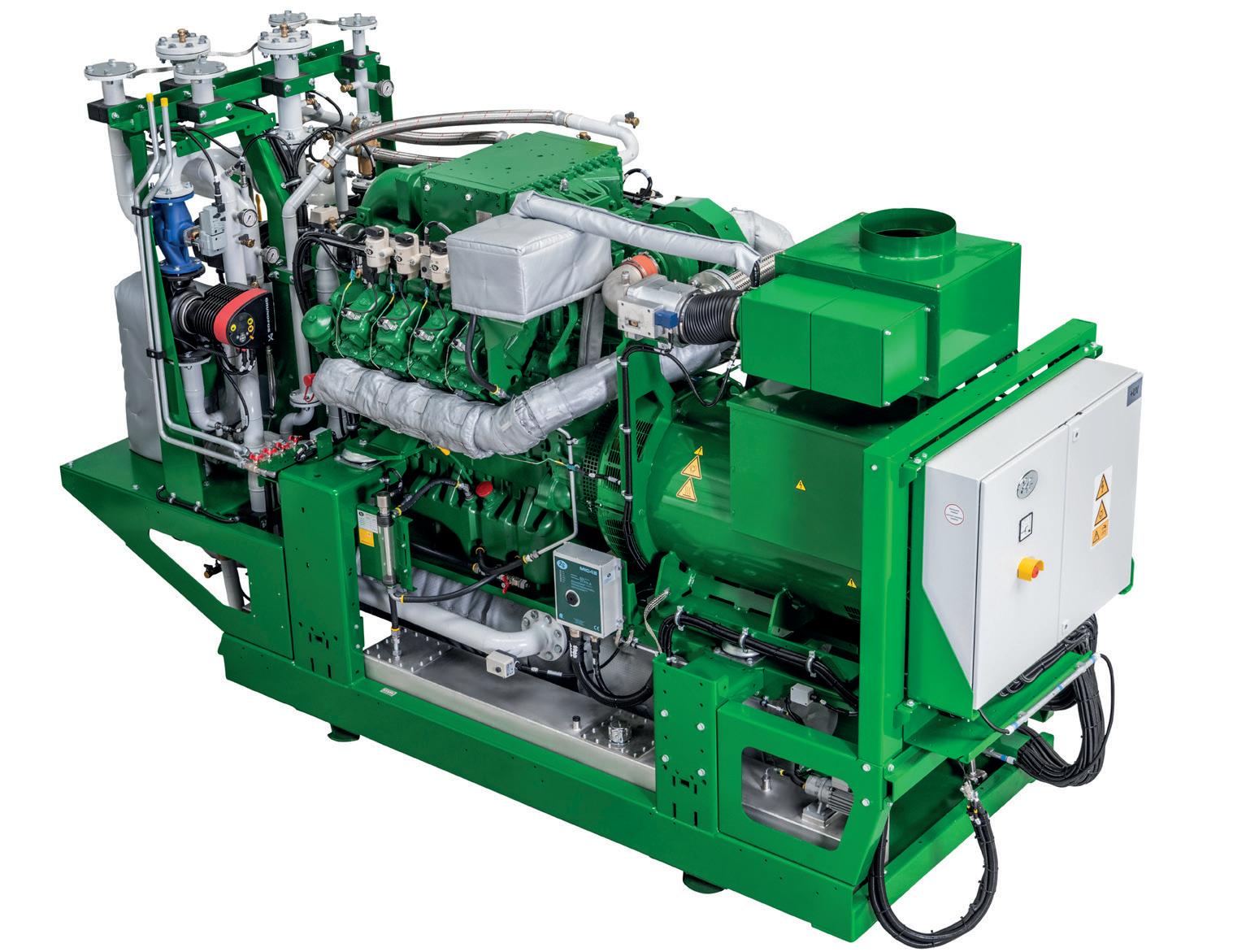
F to reduce its exposure to rising electricity costs in the next two decades.
It is also part of the Trust’s plan to reduce its carbon emissions by 25 per cent by 2025, and to reach ‘net zero’ carbon emissions by 2040.
The hospital already has a combined heat and power system and harnesses heat from a waste incinerator.
Stew Watson, director of estates development at RWT, said: “This investment is a huge boost to help us achieve that.
“Our primary focus is always on the patient and these works ensure the Trust saves money on future energy bills, which we can then subsequently invest across other healthcare services.”
Professor David Loughton CBE, group chief executive at RWT, said: “As the largest employer in Wolverhampton, we take sustainability very seriously and are committed to continually working to reduce our carbon footprint.
“We have taken a number of steps to reduce and better manage our energy consumption and operate in a sustainable manner.
“One of these steps is to look at using renewable energy so we are very pleased the development will be opening soon and delighted at the way the partnerships have worked out.”

It is also part of the Trust’s plan to reduce its carbon emissions by 25 per cent by 2025
Work has also been carried out on the underground cabling to connect the farm to the hospital.
The project has been financed by around £15 million of grant funding, including contributions from the government’s Levelling-Up fund, the NHS and Salix Finance.
A further £33 million was allocated to the Trust to carry out green energy works as part of the Department of Business, Energy, and Industrial Strategy’s Public Sector Decarbonisation Scheme.
David Mackey, chief executive of the Carbon and Energy Fund (CEF) said: “From the initial concept with the City of Wolverhampton Council to viability and Trust approval, contractor procurement, funding acquisition, technical assistance, project management and successful completion of the scheme, it’s been a pleasure to support the Trust in achieving its net-zero goal.”
City of Wolverhampton Council carried out a climate change consultation and 82 per cent of residents said they would welcome solar farms in the city. The council declared a climate emergency in July 2019.
Councillor Craig Collingswood, cabinet member for environment and climate change at City of Wolverhampton Council, said: “We have worked hard in partnership with the Royal Wolverhampton NHS Trust to bring this project to fruition on land that has been disused for years.
“This pioneering solar farm in Wolverhampton demonstrates our commitment to tackling climate change which is critical to protect our planet for generations to come.
“Since declaring our Climate Emergency in July 2019, the council has been supporting its partners towards making Wolverhampton zero carbon.
“I’m pleased to see the council supporting the local hospital in achieving its ambitions to reduce carbon emissions in the city. The new solar farm development will certainly have a positive impact in making Wolverhampton a greener city.” L
For more information, click here
Looking for a reliable and efficient decontamination service provider?


Look no further than our team of experts!
Offering decontamination services for sterilisers, washer disinfectors, endoscopy washers, laboratory & pharmacy our team can handle it all, ranging from weekly testing to full maintenance, servicing and validation.
www.axms.co.uk
Looking for a reliable and efficient decontamination service provider?




Find us on Facebook and LinkedIn


admin@auxiliummedicalservices.co.uk l 01934 352320 / 07788 726747
Look no further than our team of experts!



Looking for a reliable decontamination




Look no further than
Offering decontamination services for sterilisers, washer disinfectors, endoscopy washers, laboratory & pharmacy our team can handle it all, ranging from weekly testing to full maintenance, servicing and validation.
Look no further than our team of experts!
www.axms.co.uk
admin@auxiliummedicalservices.co.uk | 01934 352320 / 07788 726747
Offering decontamination washer disinfectors, endoscopy our team can handle it all, full maintenance,
Offering decontamination services for sterilisers, washer disinfectors, endoscopy washers, laboratory & pharmacy our team can handle it all, ranging from weekly testing to full maintenance, servicing and validation.
Offering decontamination services for sterilisers, washer disinfectors, endoscopy washers, laboratory & pharmacy our team can handle it all, ranging from weekly testing to full maintenance, servicing and validation.

www.axms.co.uk
admin@auxiliummedicalservices.co.uk Find
www.axms.co.uk
www.axms.co.uk
admin@auxiliummedicalservices.co.uk l 01934 352320 / 07788 726747
admin@auxiliummedicalservices.co.uk l 01934 352320


MRSA usually lives harmlessly on the skin. However, if the bacteria gets inside the body, it can cause a serious infection that needs immediate treatment

MRSA usually lives harmlessly on the skin. However, if the bacteria gets inside the body, it can cause a serious infection that needs immediate treatment.
An MRSA infection can lead to painful and swollen skin, that feels warm, looks red and leaks pus or liquid. If it spreads, the infection can cause a high temperature, difficulty breathing, chills, dizziness and confusion.
MRSA mainly lives harmlessly on the skin and it usually spreads through touch – i.e. touching someone with MRSA or something they have touched. It will only cause an infection if it spreads inside the body.
In a healthcare setting, some people are more at risk than they would be elsewhere, including those having long stays in hospital (especially those being treated for serious condition) and those with a break or opening in their skin (for example, a drip into a vein, a cut from surgery, a burn or wound, or other skin damage). It is also a risk for those with a weakened immune system, for example because of a condition like HIV or treatment like chemotherapy. E
Because of the reasons listed above, it is important to take every precaution to prevent the spread of MRSA.
One of the most effective ways of doing this is for everyone to practise good hand washing hygiene. Healthcare organisations should enforce and encourage hand hygiene for staff and patients and provide the facilities to do so. This should include water, soap and hygiene gel.
Patients should be provided with clear information on MRSA screening and decolonisation, in a format and language that they understand.
According to the Healthcare Infection Society (HIS), research shows that patients worry about being infected with MRSA, but at the same time, they do not know enough about it. The Evidence also shows that patients have little understanding of why they need to be screened, isolated or placed under contact precautions.
The Society recommends making patients aware of the reasons for MRSA screening and decolonisation and also informing patients of their results as soon as possible. Patients who are identified as MRSA positive should be provided with consistent appropriate information about the difference between colonisation and infection; the microorganism;

Patients who are identified as MRSA positive should be provided with consistent appropriate information

how MRSA is acquired and transmitted; how MRSA is treated; and the reasons for contact precautions or isolation.
Once discharged patients should also be informed of the risk to household members and the implications for future health and healthcare.
Visitors should also be encouraged to sit on the chairs provided and not the bed of the patient they are visiting.
Reporting avenues should be easily accessible and well advertised so that patients, visitors and staff can report if an area is visibly dirty and swift action can then be taken.
Guidelines from the Healthcare Infection Society and the Infection Prevention Society recommend patient screening to minimise transmission. Those due to have surgery may be offered a screening test before going into hospital. This usually involves wiping swabs in the nostril, mouth and groin. If the tests come back positive, patients will need to treat the bacteria with a nasal cream or spray, body wash and shampoo.
According to HIS: “Universal screening strategy has no benefit over targeted screening.” However, in some settings, universal screening may be more practical.
Standard infection control precautions are recommended in the care of all patients and
Avoid the transfer of MRSA patients between wards and other clinical settings, unless it is clinically necessary
contact precautions should be followed as per the local policy. Shared pieces of equipment should be cleaned and decontaminated after each use.
Healthcare leaders can consider placing MRSA patients in a single room, but according to the guidelines, patients should be isolated for as short a time as possible.
Surveillance should be undertaken routinely, as part of the local IPC strategy and to comply with mandatory national requirements.
Avoid the transfer of MRSA patients between wards and other clinical settings, unless it is clinically necessary. Healthcare leaders should inform the receiving setting and the transport service that the patient is infected with MRSA, so appropriate measures can be taken.
MRSA is a serious problem, so every care should be taken to prevent it. The tips above should help to reduce the spread. L

In healthcare settings, the importance of decontamination cannot be overstated. It serves as the foundation for infection control, patient safety, and the overall quality of care. HB talks to Andy Taylor about the decontamination in healthcare settings, strategies for achieving efficiency in the process, and considerations for procuring these services
Why is decontamination important in healthcare settings?
Decontamination is vital in healthcare settings due to the constant threat of infectious pathogens. Hospitals and clinics are hubs for various microorganisms, creating an environment ripe for the transmission of infections. Without proper decontamination protocols in place, these pathogens can persist on surfaces, medical equipment, and even healthcare workers’ PPE. Therefore, robust decontamination practices are essential to mitigate these risks and uphold the highest standards of patient care.
In the wake of global health crises such as the COVID-19 pandemic, the importance of decontamination has been magnified. Healthcare facilities must maintain stringent protocols to mitigate the transmission of infectious agents, ensuring the safety of patients, staff, and visitors.
How can efficient decontamination be achieved?
Efficient decontamination encompasses a multifaceted approach that integrates
various strategies and best practices. Thermal disinfection of washer/disinfectors and sterilisers is a crucial aspect of this process. These machines play a vital role in cleaning and sterilising reusable medical equipment, utilising high temperatures to eradicate pathogens effectively. Key factors for achieving efficient thermal disinfection include temperature and time control, proper maintenance, and validation processes to ensure compliance with regulatory requirements.
In the context of thermal disinfection of washer/ disinfectors and sterilisers, advancements in technology continue to refine and optimise these processes. Automated systems equipped with advanced monitoring and control capabilities enhance efficiency and reliability, minimising the risk of human error and ensuring consistent decontamination outcomes.
Additionally, chemical disinfection methods for endoscopes are integral to efficient decontamination practices. Endoscopes are indispensable tools in modern medicine, but their intricate design poses unique challenges for decontamination. Chemical disinfection methods utilise high-level disinfectants to

eradicate microorganisms effectively, with considerations including compatibility, manual pre-cleaning, adherence to protocols, and quality assurance measures.
Chemical disinfection methods for endoscopes have seen advancements in recent years, with the development of high-level disinfectants that offer rapid and broad-spectrum antimicrobial activity.
By prioritising these strategies, healthcare facilities can optimise the effectiveness of decontamination processes, mitigating the risk of healthcare-associated infections and upholding patient safety.
When procuring decontamination services, healthcare facilities must carefully evaluate several factors to ensure optimal outcomes. Firstly, assessing the reputation and credentials of service providers is paramount. Partnering with reputable companies with a proven track record in healthcare decontamination ensures confidence and adherence to industry standards and regulations.
Considering the safety of the decontamination methods employed is essential. Facilities should prioritise techniques that not only effectively eliminate pathogens but also minimise the risk of harm to patients, staff, and the environment.
Furthermore, flexibility and scalability are key considerations, particularly in the context of fluctuating demand and evolving healthcare needs. Decontamination service providers should offer customisable solutions tailored to the unique requirements of each healthcare facility, with the capacity to scale up or down as needed.
Decontamination stands as a cornerstone of infection prevention and control and patient safety in healthcare settings. By prioritising efficient decontamination practices, leveraging innovative technologies, and carefully evaluating service providers, healthcare facilities can effectively mitigate the risk of healthcare-associated infections and uphold the highest standards of patient care.
The importance of decontamination extends beyond traditional healthcare settings to encompass various other environments, including long-term care facilities, dental practices, and ambulatory surgical centres. In these settings, where vulnerable populations may reside or undergo medical procedures, stringent decontamination measures are equally imperative to prevent the spread of infections and ensure patient safety.

Having worked with companies from a thirdparty service provision company to global manufacturers, Andy Taylor has gained an extensive knowledge about the world of decontamination and the importance of it within a healthcare environment, and wanted to offer something back to the industry in the form of Auxilium Medical Services Ltd.
As healthcare facilities navigate the complexities of procuring decontamination services, collaboration with industry experts and adherence to regulatory guidelines is crucial. By fostering partnerships with reputable service providers, and investing in comprehensive training programs for staff, healthcare facilities can establish a culture of excellence in decontamination practices, safeguarding patient well-being and maintaining public trust in the healthcare system. L
www.axms.co.uk


PROVISING TECHNICAL EXCELLENCE IN ALL DISCIPLINES OF HEALTHCARE ENGINEERING .

”As the founder of GPT Consult, I take immense pride in our team of knowledgeable and experienced engineers.
With multiple AE’s we are able to support our clients in a range of ways and work as an industry leading firm of Authorising Engineers & Technical Advisors.
Our Authorising Engineers are on the IHEEM register of Authorising Engineers, giving our clients complete comfort in the level of our work”.
Graham TaylorBSc, PGDip, FIHEEM, MIET, MWMSoc GPT CONSULT FOUNDER AND CEO


The TR19 ventilation specification from the Building Engineering Services Association offers practical guidance on testing and cleaning of air distribution and kitchen extract ventilation systems to meet the required standards
The TR 19® Guide to Good Practice - Internal Cleanliness of Ventilation Systems was last updated in 2019 and incorporates reference to UK and European Standards for cleanliness of air duct systems. It also sets out best practice for ensuring that kitchen extract ductwork is maintained to minimise the risk of fire associated with grease accumulation.
A previous iteration TR/17 was published in 1998 and was intended to give guidance on best practice and also establish standards for testing, cleaning and verification of the internal cleanliness of ventilation systems.
As best practice improved, the guide was updated over the years and other regulations were also incorporated.
In 2005, the guide was republished to include further improvements to best practice and to incorporate the former publication, DWTM2 – Internal Cleanliness of New Ductwork Installations. To differentiate from the previous iteration, the guidelines were rebranded TR/19.
The second edition of TR/19 incorporated reference to the new British and European Standard BS EN 15780 Cleanliness of Ventilation Systems introduced in 2011. As mentioned above, it also includes best practice for ensuring that kitchen extract ductwork is maintained to minimise the risk of fire associated with grease accumulation, which is not covered by BS EN 15780. E
Properly maintaining ventilation systems extends their service life
F
The third and most recent version, published in 2019, withdrew section 7 and superseded it with TR19 Grease, which was a new stand-alone specification for Fire Risk Management of Grease Accumulation within Kitchen Extraction Systems.
There are many reasons that good ventilation is important in hospitals.
Adequate ventilation helps to control the spread of airborne bacteria and viruses, by diluting and removing infectious particles from the air. This reduces the risk of spreading illness between patients and healthcare workers.
It also ensures that patients receive a supply of fresh air, which is needed for maintaining a healthy indoor environment. It reduces the concentration of airborne pollutants, allergens, and other contaminants, like dust or cleaning materials that could harm a patient’s respiratory health – especially those with underlying respiratory conditions or compromised immune systems.
As well as protecting patients, good ventilation also protects staff, by protecting them from illness and ensuring they are able to continuing working.
Due to the nature of the building, hospitals often have undesirable smells floating around. Proper ventilation helps to remove unpleasant odours and create a more comfortable and hygienic environment for those inside.
§Following on from this, well-ventilated spaces improve the comfort and wellbeing of those inside the building, be that patients, staff or visitors. Good indoor air quality can improve mood, concentration and health outcomes.
Properly maintaining ventilation systems extends their service life. Ventilation systems that are not properly maintained present a serious fire risk.
Of course compliance has a role to play and that is why we are talking about the TR/19 regulations. Compliance is important for the health and safety of occupants, but also to avoid legal liabilities and penalties.
In April last year, dozens of people had to be rescued after a fire broke out in a restaurant. It

is believed the fire was started when grease in the air vent system ignited.
The foreword to the TR/19 guide to good practice from BESA states: “As air is invisible, there is a tendency to take the quality of the air we breathe for granted. Moreover, given that the average person has an air intake of about 3.4 litre of air every minute, the dangers of an inadequate or polluted air supply are obvious. This, coupled with the risk of fire from build of grease deposits in the kitchen extract systems, and the expectations of building occupiers and legislators, has resulted in an ever more stringent level of ventilation system cleanliness being required.”
Compliance with TR19 involves ensuring adequate access is provided to ductwork, inspection mechanisms, cleaning processes and that post-cleaning verification methods are met.
The guidelines explain that the ventilation system should have enough access panels, which are also of sufficient size to enable regular inspection and cleaning. The ductwork must be inspected regularly to establish whether it needs cleaning.
TR19 sets out a range of cleaning methods including hand scraping, chemicals, high pressure water wash, steam cleaning and rotary brush. However it is noted that not all methods are appropriate in each case.
After cleaning, engineers should carry out a visual inspection of the ductwork and produce a Post Cleaning Verification Report.

The Ventilation Hygiene Elite Scheme (VHE) allows businesses to self-certify their specialist hygiene works to the required industry TR19® Specification.
BESA offers certified ventilation hygiene courses enabling people to enter the industry or upskill. The courses are designed to meet the cleaning requirements of TR19 Grease.
The Vent Hygiene Register aims to set the highest standards for the industry and develop a regulated framework to ensure quality and safety for all.
The Vent
Hygiene Register
aims to set the highest standards for the industry and develop a regulated framework to ensure quality and safety for all
The register has a mission to ensure safety, equity and regulation in the vent hygiene industry by lobbying relevant organisations and ensure accessibility of the register to all, creating a level playing field for contractors. It also aims to promote safer systems and protection of people and property by informing and driving compliance and standards and work with the insurance industry to specify VHR to reduce liability and risk. L
FURTHER INFORMATION
The guide can be found here
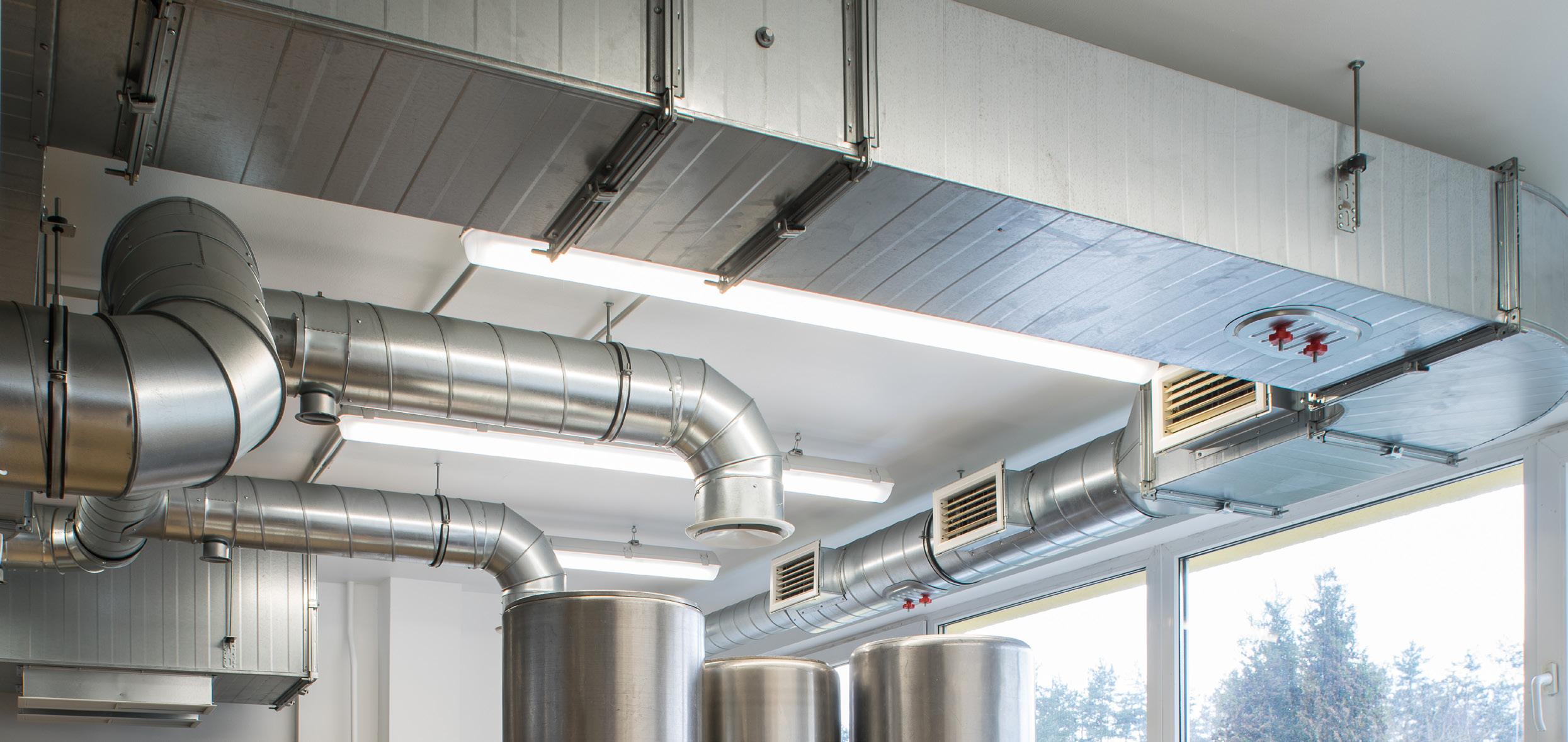
In an era marked by rapid technological advancements, shifting workplace cultures, and an increased focus on employee well-being, The Workplace Event 2024 emerges as a beacon of insight, innovation, and inspiration

Scheduled to take place from April 30 - May 2 at the NEC Birmingham, this event promises to be a pivotal gathering for over 5,000 workplace and facilities management professionals. With over 100+ exhibitors showcasing cutting-edge products and services, The Workplace Event 2024 is a hub of innovation. These exhibitors cover a diverse range of offerings, from state-of-the-art workplace technology to ergonomic design solutions and well-being initiatives.
At the heart of The Workplace Event 2024 lies an array of thought-provoking summits and seminars designed to elevate the discourse around the future of work. The Workplace Leaders’ Summit, a cornerstone of the event, brings together visionaries and influencers to delve into the latest trends shaping the workplace landscape. Simultaneously, The Knowledge Hub is divided into two distinct realms, one exploring the ever-evolving landscape of workplace technology and digital advancements, and the other delving into the realms of workplace culture, health, and well-being. Amidst the wealth of knowledge and networking opportunities, The Workplace Event 2024 introduces the Wellbeing Village
— a dedicated space focused on employee well-being. Attendees can explore the latest trends and solutions in workplace wellness, fostering an environment where physical and mental health are prioritised.
Adding an interactive and dynamic dimension to the event is “Tomorrow Meets Today.” This initiative facilitates conversations between junior FM industry members and their senior counterparts, fostering unparalleled networking opportunities. An engaging dialogue featuring Andrew Hulbert and Sajna Rahman, the driving forces behind this initiative, promises to connect professionals across generations, creating a vibrant exchange of ideas and experiences.
Another highlight is the “Unhinged” Sessions, a unique opportunity to engage directly with the foremost figures in the FM industry. Hosted by Pareto FM, these exclusive Q&A sessions provide attendees with the chance to query and interact with industry leaders. Participants can gain invaluable insights, tips, and guidance, propelling their success in the world of FM.
An integral part of The Workplace Event is the unveiling of the Workplace Leaders Top 50 — an acknowledgment and celebration of the most influential and innovative players in the facilities management and workplace design sectors. This prestigious list recognises organisations and individuals
whose contributions have had a lasting impact on the industry, setting benchmarks for excellence and pushing the boundaries of what is possible in the modern workplace.
The Workplace Data Census is another highlight, providing a comprehensive snapshot of industry trends and insights. By gathering and analysing data from across the sector, the census offers a nuanced understanding of the challenges and opportunities that organisations face in adapting to the evolving demands of the modern workplace.
This data-driven approach ensures that attendees leave the event not only inspired but armed with the knowledge needed to drive meaningful change within their organisations.
In addition to these enriching sessions, The Workplace Event 2024 boasts a Career Hub — a centralised space dedicated to helping professionals navigate their career paths. Whether you are a seasoned industry veteran seeking a new direction or a young professional eager to explore opportunities, the Career Hub offers resources and guidance to shape your future in facilities management.
The Networking Cafe provides a casual setting for attendees to connect, share ideas, and build lasting relationships. Fuel your conversations with coffee and collaboration in an environment designed to foster spontaneous interactions and the exchange of fresh perspectives.
Cap off your day of learning and networking at the end-of-day Networking Drinks. This relaxed setting provides the perfect backdrop to unwind, discuss the day’s insights, and forge connections in a more informal setting.
As professionals from diverse backgrounds come together to explore the nuances of workplace design, technology, culture, safety, security, and well-being, the event becomes a core event for the dynamic and ever-evolving world of facilities management. Whether you’re a seasoned industry veteran or a young professional eager to propel your success, The Workplace Event 2024 invites you to step into the future of work — a future shaped by innovation, collaboration, and a commitment to creating spaces that inspire, motivate, and nurture the individuals who inhabit them.
The Workplace Event is free to attend and is part of The Security & Security Series. Co-located with The Security Event, The Fire Safety Event, The Health & Safety Event, National Cyber Security Show and Professional Security Officer Live.
We also offer FREE PARKING for all visitors, saving you time and money, and giving you the flexibility to travel safely to and from the event across the full three days of the show. M
www.theworkplaceevent.com
Register for your FREE PASS here: www.theworkplaceevent.com/psi-2024



Investing in upskilling talent can make a big difference in overcoming the talent challenges in the health and care sector. In this article, Stacey Hayes-Allen, Director of Corporate Partnerships at Arden University explores how degree apprenticeships can help, and discusses the best way to implement lifelong learning into health and care practices
The COVID-19 pandemic, increasing demand for healthcare services, an ageing population and patients’ complex health conditions have all put a strain on the NHS in recent years. This has led to several new challenges, making retaining clinical and non-clinical staff more important now than ever before.
Why degree apprenticeships?
There are a few things the health and care sector needs to tackle: improving diversity, boosting staff engagement, developing leaders and meeting the changing needs of patients. Degree apprenticeships can help health and care practices to address all of these issues.
Research has shown that if employees feel happy and engaged at their NHS Trust, they’re more likely to leave a positive impact on the Trust itself. This is because employee engagement often correlates closely with absenteeism and turnover, as well as patient satisfaction, mortality and infection rates.
Several things can impact employee engagement. For example, one factor that can have a positive influence is good senior management that supports wellstructured appraisals, understands effective line management and incentivises learning opportunities. E


The NHS Long Term Plan outlined a vision for improving leadership and management within its organisations
F The research also suggests that NHS employees require information to help them perform well in their jobs. This includes learning opportunities that offer feedback to build confidence and support the development of new and improved ways of providing patient care. This can be achieved when employees have trust in their supervisors and leaders and access to effective learning and development opportunities, such as degree apprenticeships.
Utilising apprenticeship degrees can also act as a huge step in widening access to senior positions. This is because it allows those from disadvantaged backgrounds, who may not have otherwise been able to afford higher education fees, to get the qualifications – such as an executive MBA – that are often needed to enter senior leadership teams. With those from disadvantaged backgrounds being more likely to be in entry level roles, an apprenticeship degree is a good way to support them to progress further up their career ladder; it’s also a good way of retaining them to stay within your practice, if you offer the chance to fund.
As mentioned above, the health and care sector is facing bigger demand now than ever before. To keep up, a lot of practices need to upskill their workforce. In fact, one report highlights that the NHS is significantly under managed compared to other areas of the UK
workforce, emphasising the need for upskilling in health and care.
To address this, the NHS Long Term Plan outlined a vision for improving leadership and management within its organisations, with the aim of supporting more clinicians to take on executive leadership roles and supporting transitions from other sectors into leadership roles.
To enable this, there’s a need for targeted intervention at entry-level and mid-career level (for managers) to promote collaborative leadership and common organisational values, and for there to be options available for clinical leadership and non-clinical managers and leaders, to ensure preparation for leadership roles.
This will not only help health and care organisations to ensure they are implementing up-to-date knowledge and expertise for the betterment of their team and patients, but it can also ensure that those hired for entry level roles feel more driven to stay at the practice if there is a long-term career plan in place.
The guide to making sure apprenticeships work for your organisation
Degree apprenticeships are time intensive. It’s important for practices to offer the right level
Line managers supporting apprentices must actively participate in the regular progress reviews so they can support learners
of support and have a strong process in place to ensure employees are well-equipped to see their studies through to the end.
Below, we have listed out the best way to go about this:
Research has found that the most common reason why people drop out of apprenticeships is due to a lack of support. As well as this, it’s also important to have a dedicated team member who can support and guide apprentices, as well as promote courses when recruiting. This could be a passionate line manager or someone in the people team, for example. This will also make sure that learners are enrolled on to the right course for them and for the practice.
As mentioned, apprenticeship degrees are time intensive, so finding the right employee is

vital. Your apprentice should know what they want to achieve personally and professionally, and you should match this up with the overall departmental or organisational goals. Before enrolling, you should speak with employees, hold information sessions and consult with line managers to identify the most suitable apprentices.
Your practice must also provide off-the-job training to learners, with a minimum of six protected hours per week for apprentices. This time is crucial for apprentices to learn new skills and implement them in their day-to-day role. It is key to have well-established plans to ensure adequate coverage. During periods of off-the-job activities, having a strategic approach in place becomes essential to effectively accommodate and manage the offthe-job time.
The health and care sector has very unique challenges and requirements. If you’re enrolling employees on a Level 6 Chartered Manager Degree Apprenticeship, for example, you want to make sure the course is tailored to the health and care sector and, therefore, more relevant for your team. This will also ensure the knowledge they bring back to the practice is readily applicable.
Once your employee has enrolled on the course, take some time out to make sure they’re applying their learning in their day-to-day job to add value in the workplace and boost their confidence. Your education partner should be able to provide you with an overview of the knowledge, skills and behaviours their programme of study is focussing on quarterly. You can then use this as a guide to help your apprentice find workplace opportunities to try out their new learning.
Finally, line managers supporting apprentices must actively participate in the regular progress reviews so they can support learners. This involves preparing for and attending reviews with the educational institution, as well as providing support towards the implementation of the action points identified. L
For more information, click here

Safeguard your volunteers ... ... and those in their care


ID, DBS and DVLA checks
Made simple for staff and volunteers
Automatic ongoing monitoring
DBS / DVLA status updated monthly
Quicker onboarding
Volunteers can share pre-certified credentials with multiple organisations seamlessly
cdd.services/safeguarden





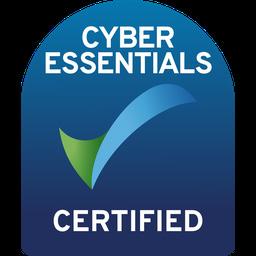

The Chancellor’s Spring Budget announced a host of different projects and funding plans across a variety of sectors in the UK. From tax cuts to vaping regulations, there were so many announcements. Robyn Quick looks at how some of this money might be spent
In healthcare, the main focus was to reform how the NHS operates with a chunk of government funding.
Chancellor Jeremy Hunt said the government plans to modernise the NHS’s “outdated” IT systems with £3.4 billion of capital investment. A part of this investment, specifically £800 million, will introduce technology to free up time for staff at the front line of public services.
Chancellor Jeremy Hunt said that the aim is to “reduce the 13 million hours lost by doctors every year because of old IT.” He said in the Budget that this would be done by using artificial intelligence (AI) to tackle issues like late appointments that are often dealt with by healthcare workers.
After the Budget was announced, secretary of state for science and technology Michelle Donelan, said: “The public and economic benefits technological and scientific innovation can drive are immense.
“That is why I am focused on delivering this government’s record level of investment to cement the UK’s place as a Science and Technology Superpower.”
She said that the Budget put the NHS “firmly on the path to delivering this goal.”
Donelan added: “Whether channelling technological advances into the public sector or doubling down on our leadership in AI advances and safety, we are unleashing innovation to drive economic growth and prosperity for everyone.”
AI is an ever-expanding world covering so many different areas, so what will the AI proposed by the government actually be doing?
NHS England announced their plans for how AI in healthcare will supposedly slash doctors’ wasted hours on 14 March.
They said they will roll out AI to reduce the number of missed appointments and free up staff time to help bring down the waiting list for elective care.
Created by Deep Medical and co-designed by a frontline worker and NHS clinical fellow, the software is meant to predict likely missed appointments through algorithms and anonymised data, breaking down the reasons E
For any stakeholders you want to reach get people focussed insights you can act on STAFF


Our experienced team of researchers provide the personal touch during your project, at every point, from designing the questionnaire through to presenting the findings and helping you get the insight that you can take action on




F why someone may not attend an appointment using a range of external insights including the weather, traffic, and jobs, and offers back-up bookings.
This kind of work is usually handled by healthcare staff, and can be taxing and timeconsuming.
The appointments are then arranged for the most convenient time for patients – for example, it will give evening and weekend slots to those less able to take time off during the day.
The system also implements intelligent back-up bookings to ensure no clinical time is lost.
It has been piloted for six months at Mid and South Essex NHS Foundation Trust, leading to a 30 per cent fall in non-attendances. A total of 377 did not attends (DNAs) were prevented during the pilot period and almost 2,000 additional patients were seen. It is estimated the trust, which supports a population of 1.2 million people, could save £27.5 million a year by continuing with the programme.
It may seem surprising considering the difficulty that some patients have to book an appointment, but published data shows that of 124.5 million outpatient appointments across the NHS in England last year, eight million (6.4 per cent) were not attended by the patient.
It is estimated this level of missed appointments has an annual cost to the NHS of £1.2 billion.
Figures for last year also show the highest proportion of missed appointments were physiotherapy – with more than one in 10 appointments marked as DNAs (11 per cent) – followed by cardiology (8.9 per cent), ophthalmology (8.8 per cent), and trauma and orthopaedics (7.9 per cent).
It is estimated this level of missed appointments has an annual cost to the NHS of £1.2 billion
AI scanners are also on the way as part of the government’s further investment into technology.
The Chancellor promised 100 new AI-fitted MRI scanners that will aim to help doctors deliver results more quickly and accurately to 130,000 patients every year.
These scanners will be introduced as part of the community diagnostic centre (CDC) programme backed by part of the £2.3 billion capital investment in diagnostic transformation.
Andrew Stephenson, health minister, said: “Diagnostic centres are playing a vital role in helping to cut waiting lists by delivering checks and scans to people who need them, helping reduce pressures faced by hospitals across the country.
“This is a key part of our long-term plan to make the NHS faster, simpler and fairer for patients.”
The government said the CDCs for NHS patients will be placed in easy-to-reach locations like shopping centres and near football stadiums so they are easy to access for more people.
There are already 155 CDCs open across the country, which the government said plays a crucial role in faster diagnosis for illnesses such as cancer and heart disease. L













Collaboration simpli ed with a built-in 5 MP webcam, a noisecancelling microphone, and speakers

In today’s fast-paced world, technology has become an indispensable tool, revolutionising various industries, including healthcare

With advancements in digitalisation, artificial intelligence, and communication systems, the healthcare sector is witnessing a significant transformation, promising improved patient care, streamlined processes, and enhanced efficiency. Amidst this paradigm shift, companies like 2CL Communications Limited are playing a crucial role in empowering healthcare providers with innovative solutions tailored to clients’ specific needs.
The integration of technology in healthcare has brought forth numerous benefits, ranging from remote patient monitoring to electronic health records (EHR). These advancements contribute to facilitating better patient outcomes and optimising resource utilisation and operational workflows within healthcare organisations.
2CL stands at the forefront of this technological revolution, offering comprehensive communication solutions designed to address the evolving needs of healthcare providers. One of the key areas where 2CL excels is technology integration, enabling healthcare professionals to utilise unified communications to assist remote diagnosis, monitoring, and treatment of patients through secure and reliable communication. With their cutting-edge technology, 2CL ensures seamless video conferencing and real-time data exchange, fostering a virtual healthcare environment that transcends geographical barriers.
Furthermore, 2CL Communications Limited specialises in secure platforms, facilitating efficient communication among healthcare teams while ensuring compliance with stringent data privacy regulations such as Data Protection Act 2018. By implementing secure platform solutions, healthcare providers can collaborate effectively, share critical patient information, and coordinate care plans in a timely manner, ultimately enhancing patient safety and satisfaction.
Moreover, 2CL Communications Limited place a strong emphasis on cybersecurity, recognising the critical importance of safeguarding sensitive patient information against potential threats and breaches.
Through robust encryption protocols, intrusion detection systems, and continuous monitoring mechanisms, 2CL, and their partners, ensure the integrity and confidentiality of healthcare data, bolstering trust and confidence among patients and healthcare professionals alike while increasing efficiency in productivity.
In conclusion, the integration of technology in healthcare is revolutionising the way patient care is delivered, and companies like 2CL are at the forefront of this transformation. With innovative communication solutions, including unified communication, secure platform systems, and cybersecurity measures, 2CL is empowering healthcare providers to embrace the digital age delivering high-quality care in an increasingly interconnected world. As the healthcare landscape continues to evolve, the role of technology will only become more prominent, and companies like 2CL will remain pivotal in driving innovation and shaping the future of healthcare delivery. M
2cl.co.uk
L EF
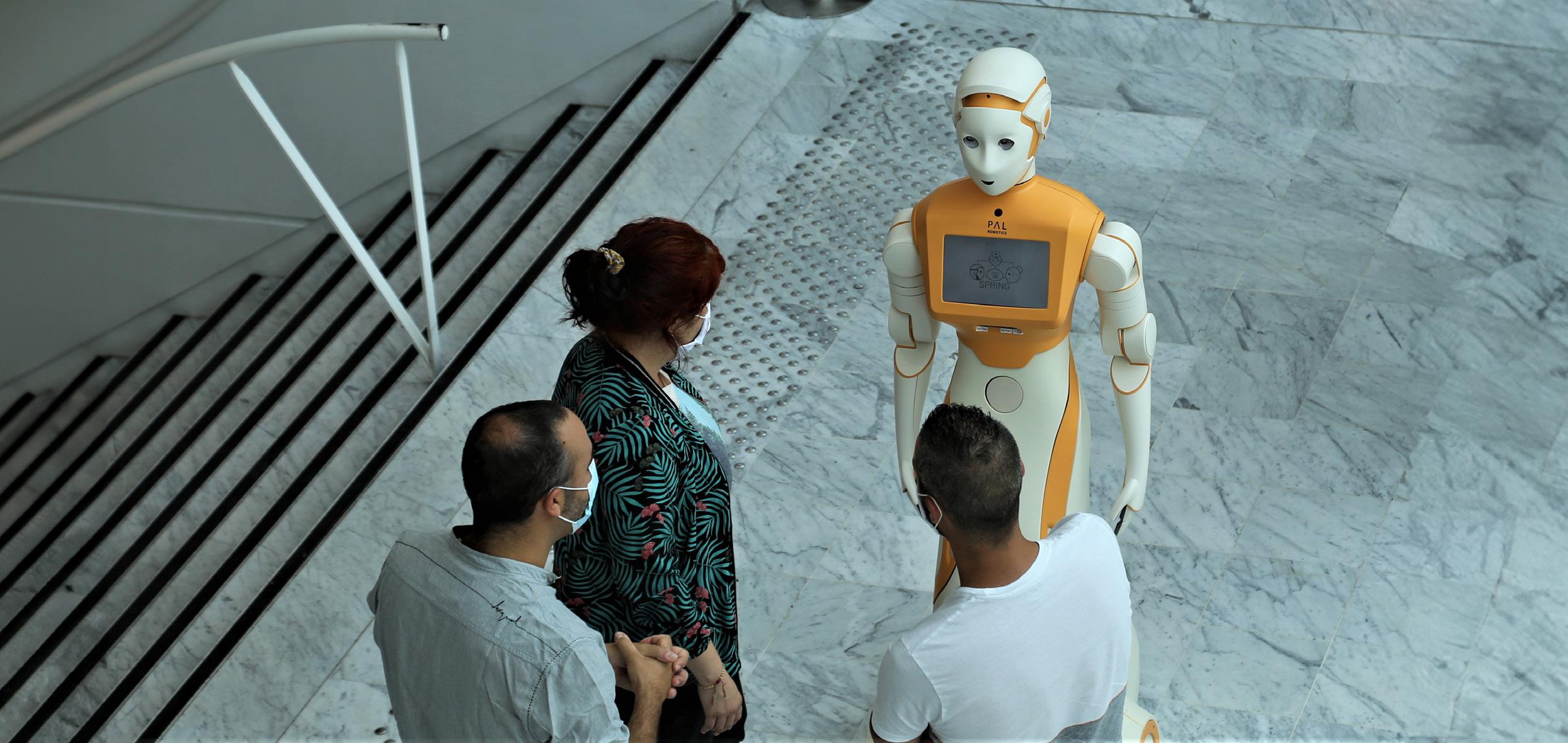
As our health services face ever-increasing demands and financial constraints, the potential for artificial intelligence (AI) and robotics to revolutionise healthcare delivery is gathering momentum - and for good reason.
With a 9.9 per cent staff vacancy rate in our healthcare services sector as of the end of March 2023, according to the NHS, socially assistive robots in hospitals could ease pressure on nursing staff, while alleviating patient anxiety. Conversational AI systems or physical robots can also assist with cleaning duties or even support surgical procedures. The benefits are only bound by our collective imaginations.
The growing integration of advanced technologies into hospital workflows is helping to significantly improve patient outcomes, enhance care accessibility, and optimise budgets. And we at the National Robotarium are wholly supportive of tech being introduced into the healthcare environment.
One of the most promising avenues for healthcare robotics is in supporting the roles of doctors, nurses, and other care professionals.
By automating repetitive or physically demanding tasks, intelligent systems can help alleviate staff workloads, allowing our healthcare workers to focus on what they do best - providing compassionate, human-centred care.
If we can make a person’s job less dull, less dirty, and less dangerous, not only will they be able to do their job better, but they will likely stay in the role longer and experience more job satisfaction.
At our facility, we’ve set up a dedicated space called the LARA Lab, which is an assisted living laboratory used by our researchers and partners to deliver research, and aid those managing health conditions to remain independent in their homes for longer. This lab is fully kitted with a kitchen, lounge, bathroom and two bedrooms to simulate a living experience where working experiments are regularly conducted.
We also have a strong working relationship with Blackwood Homes and Care, a housing association and care provider with over 100 developments across mainland Scotland. Blackwood’s innovation team is working with us to enable innovative tele-care, tele-health E




F and social robot applications, by fully integrating a mobile and interactive robot with Blackwood’s digital ecosystem. This will allow the residents to trial socially assistive robots in real time, in their own homes.
Similarly, we’re working with Leuchie House, a national respite centre that supports people with MS, who have had a stroke or who are living with a number of other neurological conditions. By trialling technologies that could help people gain greater independence, or by providing support after a stroke or monitoring for deterioration in conditions like dementia, we’ll be alleviating some of the pressure faced by healthcare professionals on a daily basis. The data that’s gathered will make a huge difference both to the patient and to the carer.
The FEATHER research project – delivered in partnership with the School of Informatics at The University of Edinburgh - is another great example where AI and robotics are having
Robotic physiotherapy systems could provide personalised therapeutic interventions in community settings
a direct positive impact on the healthcare industry. This innovation uses pressure sensors and activity monitoring to detect changes in an older person’s behaviour that could signal a potential health issue, like urinary tract infections. This method ensures that care professionals receive around the clock monitoring and are also alerted to subtle changes in the person’s daily habits or movements.
Beyond supporting healthcare staff, robotics and AI also have the potential to directly enhance patient experiences and outcomes. Robotic physiotherapy systems could provide personalised therapeutic interventions in community settings. Bioliberty, one of our tenant companies, has developed a robotic glove which assists in strengthening hand weakness as part of its purpose to enhance stroke rehabilitation. It also allows patients access to care closer to home while reducing hospital and GP wait times, easing pressure on support staff and optimising outcomes.
Surgical robots are also advancing rapidly, with systems becoming increasingly capable of assisting surgeons during complex procedures. Anecdotally, I recently had a surgeon visit the National Robotarium who inquired about the possibility of a robotic brace for himself that E


F could prevent strains and fatigue for surgeons during operations in the theatre. This is a great indicator of how many health professionals are increasingly willing to adopt AI and robotics into their own daily practice.
Touchlab, the first tenants into the National Robotarium are developing and manufacturing a biomimetic e-skin system that is thinner than human skin and can be used with hard or soft robotics to sense pressure, location and direction in real-time. Their unique nanotechnology enables surgeons and operators to experience ‘true presence’ through a machine whilst being able to withstand extreme environments and temperatures. The technology is being applied to solve grand challenges across a vast range of existing and untapped markets, including healthcare, nuclear decommissioning, medicine, automation and space robotics.
In the realm of diagnostics, AI-powered systems also show promise in enabling earlier and more accurate detection of health issues. This is paving the way for proactive, personalised care based on vast amounts of data, including an individual’s genetics and environmental factors.
While the potential benefits of healthcare robotics are of course vast, and there is fantastic technology being evidenced around the country, a number of hurdles need to be addressed
Patient acceptance and trust are also critical factors in the successful deployment of healthcare robotics
before widespread adoption can occur. Robust testing and co-production with stakeholders, for example, needs to take place before we can collectively adopt new technologies.
That’s where the National Robotarium comes in. We’re conducting research which aims to advance robotics, while working with health and care organisations to see through the very busy tech landscape. Once we understand their needs and what technology is right for them, we can make recommendations on how to implement the necessary research, AI and robotics into their chosen focus area. We’ll then work with health care businesses on how the changes will impact their priorities of patient outcomes and budgets. We are actively and continuously engaging with health boards, providers, and policymakers to identify and overcome any barriers to adoption and we’re very pleased that the response has been really positive.
Patient acceptance and trust are also critical factors in the successful deployment of healthcare robotics. The National Robotarium consistently carries out research to understand what is acceptable to patients and caregivers, in terms of factors such as robot appearance, facial features, voice, and social behaviours.
Every person has their own personal views and experience of robotics, and through innovative research, we’re trying to understand what is acceptable or what people would prefer to see.
As robotics and AI systems augment the roles of care professionals more and more, these technologies may attract new talent to healthcare careers
Our specialist Professor in Developmental Psychology, Thusha Rajendran, often discusses the relationship between humans and robots, exploring ways to build trust between man and machine. He believes, and we agree, that a fusion of psychology, engineering and computer science can create exciting new robotics innovations that can make our lives healthier and safer.
Additionally, we’re committed to addressing practical concerns like cybersecurity and ensuring fair, ethical and inclusive access to robotic technologies. In collaboration with the University of Edinburgh and Heriot-Watt University, the facility has secured funding for a centre to train the next generation of PhD candidates in building trust in robotics.
Beyond enhancing care delivery in urban hospitals, healthcare robotics have the potential to address challenges of access and care equity for rural and remote populations. For example, one of our researchers, Dr Mauro Dragone led on a project that pioneered intelligent sending and tele-presence robotic technology to help health practitioners remotely assess a person’s physical and cognitive health from anywhere in the world.
Because a person’s physical and cognitive abilities change over time, these prototypes use machine learning and AI to carry out nonintrusive assessments, delivering data 24 hours a day, seven days a week. This information is invaluable for the patient’s healthcare professional. What’s more is that this project allows the carer to interact with the patient directly, seeing through the robot’s eyes and ‘moving’ around the room where necessary and even responding to emergencies.
As robotics and AI systems augment the roles of care professionals more and more, these technologies may attract new talent to healthcare careers, helping to alleviate staff shortages and improve access to care across diverse regions.
The National Robotarium has been involved in projects ranging from medicines discovery and manufacture, to robotics surgery and stroke rehabilitation, and I foresee real, tangible impact from all of them over the next 12 months. There are advances in every area of healthcare, and the pace of change is accelerating all the time. We, as a society, are on the precipice of some pretty major and exciting developments.
As a facility we’re driven by real-world need and are ready to assist businesses and industry with the best solutions to their automaton needs. We’re co-producing solutions with the people who are experiencing challenges every day, and that means engaging with healthcare staff - not only clinicians and allied professionals but procurement teams, site management, HR, and training. The better we can build a picture of our healthcare systems, the better we can optimise solutions and prove the case for mass adoption.
As the transformative potential of healthcare robotics continues to unfold, The National Robotarium stands ready to collaborate, innovate, and lead the way toward a future where AI and intelligent systems play a vital role in improving health outcomes for all. L
The National Robotarium

Lisa Farrell, business development manager at the National Robotarium
Three NHS Trusts in north east England are forecasting multi-million pound procurement savings due in part to a new, single technology system


Humber & North Yorkshire Procurement
Collaborative is responsible for some £550m of annual spend across the operations of Yorkshire & Scarborough, Hull and North Lincolnshire and Goole NHS Trusts.
The legal introduction of Integrated Care Systems in July 2022 has led to the consolidation of procurement processes at the three trusts into one operation, with streamlined governance and systems.
Edd James, Director of Procurement at the collaborative, hopes to achieve over £15m of savings per annum within five years due to better efficiency and increased purchasing power.
The efficiencies are largely possible due to the introduction of new technologies provided by procurement tech specialists Elcom Systems. The solutions include: sourcing software for quicker supplier quotations; product catalogues shared across systems; integrated procurement software which can interface with finance programmes; inventory management with the ability to transfer stock between hospitals; electronic invoicing for sending orders and receiving invoices.
Mr James said he hoped that the figure of 266,000 invoices currently received each year by the trio of trusts could be significantly reduced - massively saving accounting costs and improving efficiency.
“It’s always been frustrating to see our staff having the latest in tracking and delivery apps for their orders at home, yet nothing similar is available at their workplace,” he said.
“In addition, some of our suppliers are sending us ten thousand invoices per year, each of which has to be individually dealt with. Better systems will improve the ordering process, avoid duplications, provide better information and reduce ordering and invoicing requirements.
“It’s also urgent that we get our teams across the trusts working together as one. We’re introducing standardised governance as well as systems, so the procurement operations can coordinate their activity and work together. That will in turn improve our purchasing power and allow us to negotiate prices with our suppliers.
“I expect we can create major savings through these systems. I joined two years ago and we’re already expecting £4.5m of
savings this year - that’s a figure we can drive up significantly and I’m forecasting that we will double this within the next two years, with further savings to come.”
Eleam, which has UK offices in London, Glasgow, Birmingham and Liverpool, has already successfully deployed smart procurement with several NHS operations across the UK, including major projects with the Scottish Government and health trusts like North Central London NHS and South West London NHS.
Ian Slaughter, VP of Product at Eleam, said: “The introduction of the ICS model offers health trusts the opportunity to bring procurement and supply chain functions together to assist in driving efficiency.
“We know that technology offers an opportunity to streamline and economise services. However to date the problem has been a lack of overarching systems which provide a modular and holistic platform from which organisations can operate.
“Our work with the Humber & North Yorkshire Procurement Collaborative will offer further demonstrations of how sourcing, procurement and inventory software can be delivered to save NHS Trusts considerable amounts of time and money - allowing resources to be better dedicated to the treatment of patients.”
Mr James said: “We were looking to improve the digitisation journey in procurement, put a system in place across the three teams, and also interface into three e-finance systems.
“Eleam has delivered that elsewhere, and we spoke to Scottish Government, North Central London NHS and South West London NHS for references on the work they’ve done and the systems they’ve interfaced to, to give us the confidence that they would be able to do that work. We’re looking forward to seeing the benefits of the new systems.” M FURTHER
www.elcom.com
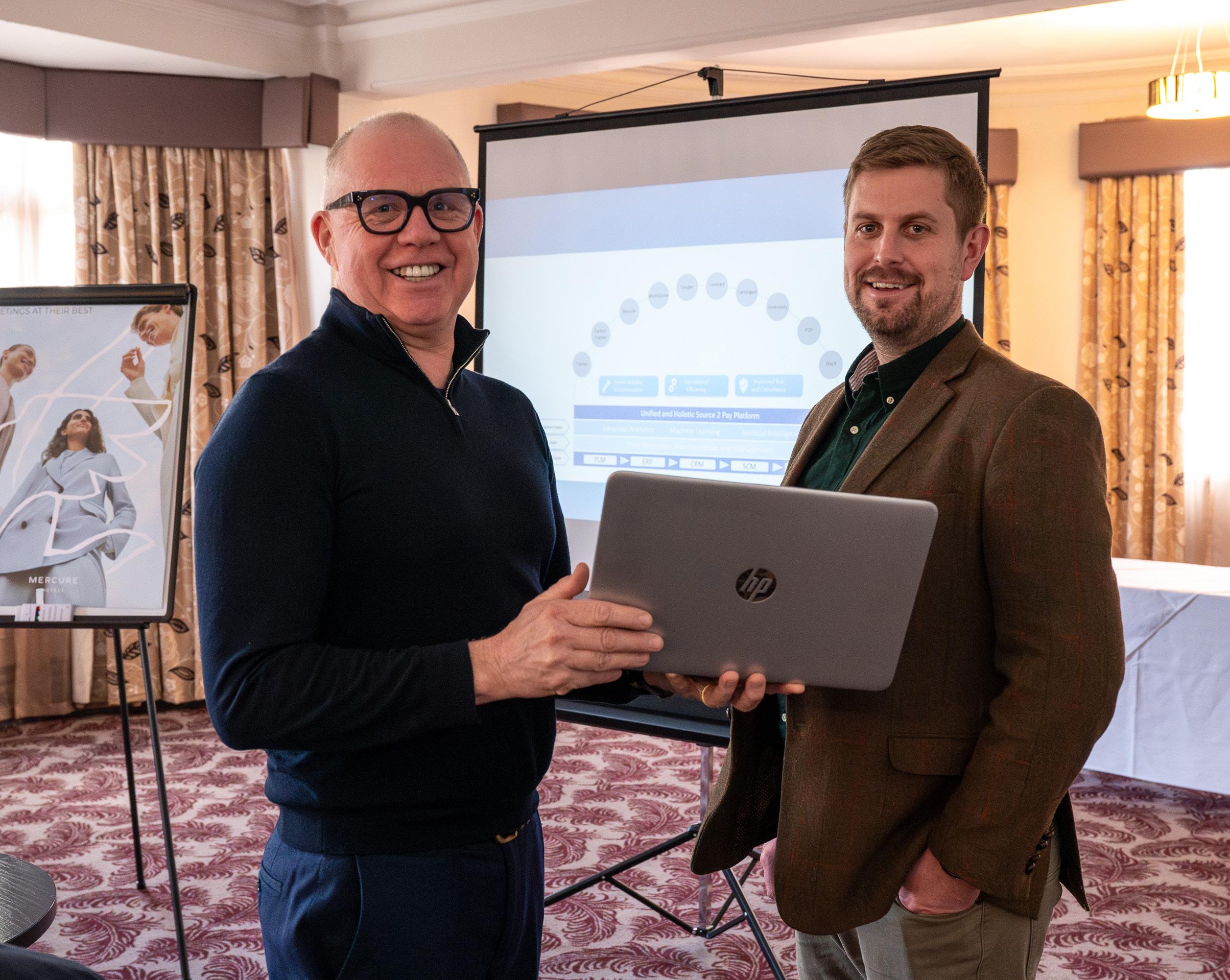

Why are the health benefits of 51 per cent of the population so often overlooked?
Dr MaryAnn Ferreux, medical director at Health Innovation Kent Surrey Sussex (HIKSS), and Melissa Ream, specialist commercial advisor, HIKSS, share their perspectives on the potential opportunities in femtech and women’s health, and how we can work together to reap the benefits

Women’s health has historically faced challenges and disparities, with issues often overlooked across all sectors. Not only with regards to conditions solely affecting women, but also understanding the different physiological responses that women have in areas such as cardiac disease and immune responses. It is also known that women use health technology differently to men, presenting clear opportunities to deliver measurable health benefits to over half of the population, as well as a huge market opportunity for businesses to target.
Femtech and women’s health innovation are increasingly growing areas, however there is a risk that the promise of these areas is not realised without recognising the challenges that remain. Dr MaryAnn Ferreux, medical director at
Health Innovation Kent Surrey Sussex (HIKSS), and Melissa Ream, specialist commercial advisor, HIKSS, share their perspectives on the potential opportunities in femtech and women’s health, and how we can work together to reap the benefits.
What are the major challenges facing women’s health in the UK?
MaryAnn Ferreux: The main challenges in women’s health stem from decades, if not centuries, of gender bias and discrimination. In the past, many women’s health complaints were attributed to being emotional or hysterical and these gender stereotypes often led to doctors mistreating women’s symptoms as a mental health condition, rather than a physical condition.
While that has changed, much of this inherent gender bias remains, with many clinical trials and research studies not assessing the impact on women. We have recognised that there is a gender-based data gap but now we need to overcome this. Data sets are very rarely analysed by gender, and yet it is almost universally recorded, so the disparities in how genders respond in different disease groups could and should be analysed routinely.
Melissa Ream: We often think about women’s health in terms of women’s conditions, be that menstrual health, maternity or menopause. But women’s health care is general health care too. The cardiac symptoms and risks for women are different to men, yet these are not widely known. And this comes down to under representation of women in data sets as well
We have recognised that there is a gender-based data gap but now we need to overcome this
as unconscious bias in the wider world. If you search for images of people having a heart attack on Google, most of the images will be of men. Cardiovascular disease in women is a bigger killer than breast cancer and we need to start taking this more seriously, looking at how our clinical services are designed, delivered and promoted.
MaryAnn, you mentioned data sets. Do you think AI has the power to change this or do these concerns remain?
MaryAnn Ferreux: AI has a lot of potential to improve the health experiences of women, but there is a risk of building in more inequality if we do not address gender bias in data sets. More and more innovators are wanting to use AI in their technologies but some of them are not thinking about bias until it’s too late. A global analysis of AI systems found that 44 per cent demonstrated a gender bias. We need to ensure that the data sets used are comprehensively analysed and shown to be relevant to the target population and this comes down to the decision makers asking the right questions, whether that’s innovators, regulators, funders or purchasers. I’m also concerned about a lack of leadership in AI regulation and who is at the decision-making table. Without diversity at E


F that top level, it is unlikely that the right questions will be asked early enough –retrofitting later on just won’t work!
Learning from experience presents a huge opportunity, but one that we haven’t been previously good at. As an example , a lack of ethnicity data incorporated into skin algorithms resulted racial bias in pulse oximetry, ensuring that the device was not as effective for black and ethnic minority people. This disparity has been observed since the 90s and yet the device was still used during the Covid-19 pandemic, resulting in worse outcomes for black and ethnic minority people. We didn’t address the problem when we had the chance, and we need to ensure this doesn’t happen again.
So, what do we need to do to support equality in healthcare?
Melissa Ream: As MaryAnn says, having people at the decision-making table is vital to ensure that equality is incorporated into our systems. There is still a shortage of women in leadership roles even in the femtech industry and this needs to change, from more women at C-level, to more women investors. With women making up just 22 per cent of AI workers, we need active engagement from all sides to help make this
If you can’t look above for inspiration then you’re unlikely to move in that direction
change. Role models are a powerful tool; if you can’t look above for inspiration then you’re unlikely to move in that direction. It’s therefore so important that we build networks to support this.
Innovation hubs like Discovery Park play a powerful role in this, providing a network to support women in leadership positions and a platform that draws attention to the issues and also to those overcoming them. When we see good practice, let’s talk about it!
MaryAnn Ferreux: To make change happen, we need to use both a stick and a carrot. There must be something built into our structures and processes that sets out expectations and ensures compliance with health equity. But we also need to use financial levers as a carrot, with investors and purchasers demonstrating an interest in this area and making decisions that reflect a commitment to reducing health inequalities.
What would be on your women’s health manifesto to help guide this change?
MaryAnn Ferreux and Melissa Ream: There are three areas to focus on that we believe will see real results:
Leadership – Women currently make up just 20-25 per cent of leadership in digital, tech and AI. This needs to change to reflect the wider population and their health care needs. We also need to promote and support women innovators to enter Femtech and maximise commercial opportunities that improve women’s health.
Policy and Commissioning – Those determining the focus of our health and care policies need to be inclusive and incorporate diversity requirements, ensure that a wide range of women’s voices are heard, and that commissioning reduces gender health gaps. Data sets – Data sets need to reflect their target audience and not exclude minority groups. Existing data sets may not be inclusive, so trials and data sets need to be designed and analysed with this in mind. This also presents an opportunity where having a comprehensive understanding of the data can result in the
development of more tailored care including personalised interventions with the potential to reduce health inequalities.
You’re both based in Kent. How important do you think local networks are to support these changes?
Melissa Ream: Change doesn’t exist in a vacuum, it takes work across the entire system, and local hubs are an excellent starting point. By working together locally to understand the problems and bringing together groups to address these problems, we can see real impact. There are important roles for everyone within the industry, from the NHS to individual companies, hubs like Discovery Park and national networks like Barclays Eagle Labs and Health Innovation Networks. If we collaborate, we can make health care more equitable, close the gap and reduce inequalities.
MaryAnn Ferreux: Discovery Park is in an exciting position, embedded in the start-up community but with close links to the NHS and academia, there is opportunity to set a standard and drive this campaign forward. Discovery Park Ventures is already investing in women-led femtech companies, and I enjoyed joining the team at Giant Health to discuss the challenges and opportunities in this space. E

Change doesn’t exist in a vacuum, it takes work across the entire system
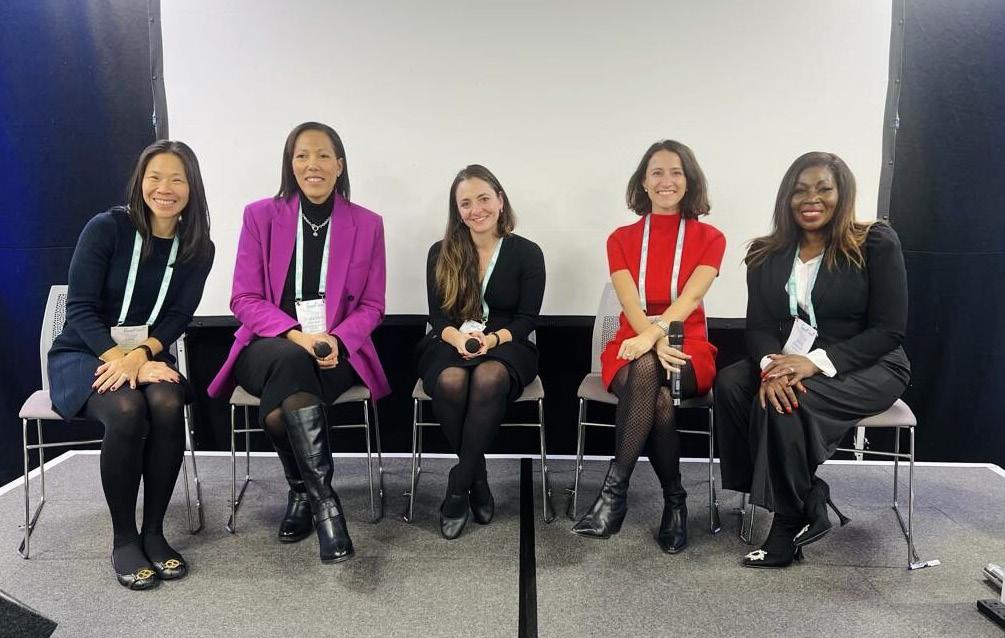
By working together locally to understand the problems and bringing together groups to address these problems, we can see real impact
F
Discovery Park recently hosted a panel at Giant Health on ‘Unlocking Opportunities in Women’s Healthcare’. The panel was moderated by Sylvia Stevenson, founder, Absolute Diversity, and featured Dr MaryAnn Ferreux, medical director, Health Innovation Kent Surrey Sussex; Lina Chan, Holland & Barrett general manager wellness ventures and CEO, Founder at Parla; Melisa Guven, associate, Monograph Capital; and Karina Vazirova, co-founder & CEO, Femtech Lab. L
FURTHER INFORMATION
https://healthinnovation-kss.com/
About the authors
Dr MaryAnn Ferreux MBChB, DipPM, MPH, FRACMA, FCHSM, FFCI, CHE
MaryAnn is the medical director for the Kent Surrey and Sussex Academic Health Science Network, providing innovation leadership for the NHS. She has international experience working across both the Australian and UK health system, with specialist qualifications in health system leadership, management, and public health. She has held Board level roles as a medical leader in both primary and secondary care and is passionate about improving the patient experience and delivering better integrated care.
She is a Fellow of the Royal Australasian College of Medical Administrators, Australasian College of Health Service Management and Faculty of Clinical Informatics, as well as being


a Certified Health Executive and leadership coach. She has a special interest in researching health equity and the impact of the social determinants of health; her current doctoral studies will explore health inequalities within the Kent and Medway region.
She is leading a number of initiatives to promote diversity and inclusion in healthcare and is a trustee and chair of the Royal College of Physicians Edinburgh Equality, Diversity and Inclusivity Committee and chair of the Royal Australasian College of Medical Administrators Diversity & Inclusion Committee. MaryAnn is committed to using her position to role-model an inclusive leadership approach whereby she supports, mentors and coaches clinicians from disadvantaged backgrounds to widen participation in medicine and increase diversity within healthcare leadership and management.
Melissa Ream
A Texan living in Canterbury, Melissa has been leading transformational change in England for over two decades, working across the whole healthcare system, FTSE 100 companies, trade bodies, the AHSN Network and a range of central government departments, including what is now DHSC and NHSE. She served as national lead on a wide range of complex programmes and topics, including: artificial intelligence; commissioning packs; transactions, mergers and acquisitions; non-pay procurement; women’s entrepreneurship and innovation; and broadband.
Melissa earned a Bachelor of Science with a concentration in Medical Humanities from Davidson College in North Carolina, and an MBA and Master of Public Affairs (health policy) from the University of Texas at Austin. She enjoys travel and pre-COVID regularly led study tours to destinations such as Denmark, Finland, Estonia, London and Austin, Texas.
02920 790784 | 07725 947217
info@djhillengineering.co.uk

www.djhillengineering.co.uk
Welcome to the Hospital Bedstacker. The Bedstacker is available in 3, 4 and 5 Bed configurations for vertically stacking hospital beds. The Bedstacker has a small footprint with simple push button operation, full safety guarding and safety locking gates. D J Hill Engineering Services Ltd can supply and fit nationwide and also provide extended warranties and servicing.
023 9263 0276
sales@hooperservices.co.uk
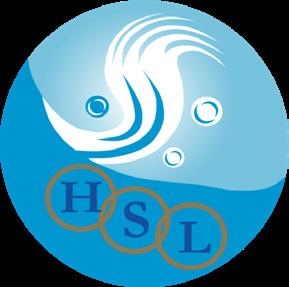
https://hooperservices.co.uk
Hooper Services have been at the cutting-edge of cleaning technology for over 30 years; we pride ourselves on having the answers to all your facilities management needs. With over a century of combined engineering expertise at your disposal, whether you require advice or a free demonstration , we have you covered!
TOTAL CLEAN
020 7935 5088
enquiries@totalclean.co.uk

www.totalclean.co.uk
Total Clean’s healthcare cleaning service ensures a secure medical environment, prioritising patient safety. With over 35 years of experience, we adhere to CQC and BICSc standards, mitigating infection risks. Trust us to create a safe space for your staff and patients in compliance with the highest cleanliness and hygiene standards.
01252 551540
Award-winning specialist design, supply, and service of sustainable water heating. Gain insight on existing systems with Live Metering, reduce carbon and mitigate cost of moving from gas to electric. Talk to Adveco about commercial heat pumps, solar thermal, water heaters, electric boilers, cylinders, packaged systems, and offsite constructed plant rooms. ADVECO
enquiries@adveco.co

https://adveco.co
01942318096

Our range of emergency products and equipment offer protection against serious injury and are all built to exceed ANSI/EN safety standards. We have the flexibility to adapt, modify or design bespoke units for each individual customer in our UK manufacturing facility. AQUA

01727 860657
office@tfinstallations.co.uk
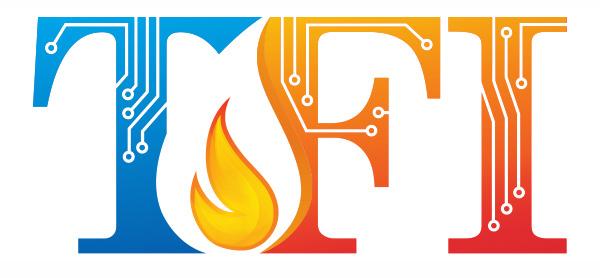
www.tfinstallations.co.uk
TF Installations Ltd has been working in the fire detection industry for over 30 years. We can install, maintain and service Analogue Addressable Systems, Radio Fire Detection Systems, Conventional Fire Detection Systems, Air Operated Vent systems, Aspirating Systems, Graphical Packages, Emergency lighting and Fire extinguishers.
01280 706640 | 07572 236044
info@quenelles.co.uk

www.quenelles.co.uk
We’re independent and market leading we have been benchmarking Food Service prices for 30 years, we’re impartial, accurate and confidential. Our data ensures you have control over your catering purchases allowing you to find opportunities to improve your buying. Giving you the assurance that you’re competitive or highlighting your opportunities.
01243811881
sales@murrayequipment.co.uk

At
ECOGRIT
0800 193 6466
gaz@ecogrit.co.uk

ecogrit.co.uk
EcoGrit supplies a granular deicer which is safe to use around plants, children and animals. It is effective to below -20C and isn’t corrosive like rock salt. EcoGrit Concentrate is used by emergency services, wildlife trusts, English Heritage, National Trust, vets, councils and maintenance contractors to name just a few.
ESTS (GB) LTD
01933 270999 / 07399 296544
Victoria.chegwin@estsgb.net

https://autoclave.uk.com/
Autoclaves/sterilizers, glass washers & washer disinfectors. As a leading manufacturer of sterilizers in the UK, we supply, maintain & support the Logiclave brand of autoclaves, glass washers and washer disinfectors. Our autoclaves suit a wide range of applications including multi-purpose laboratories, high-security containment labs, hospital sterile services, and pharmaceutical and veterinary sterilization rooms.
LEGIONELLA
EVOLUTION WATER SERVICES
0118 934 4400
healthcare@evolutionwater.co.uk

evolutionwater.co.uk/healthcare
Don’t let water hygiene compliance doubts compromise patient care. Evolution Water Services is your pathway to certainty in water hygiene excellence. We simplify the complexities of water hygiene regulatory adherence, allowing healthcare professionals to dedicate their focus to what matters most—exceptional patient care.

info@albagaia.com hydrosense-legionella.com
Discover the Hydrosense easy-to-use rapid Legionella pneumophila test: Hydrosense PRO detects serogroups 1-15 within 25 minutes. Get immediate water safety with real-time results whilst waiting for lab results. This Legionella species causes over 97% of confirmed Legionnaires’ disease outbreaks so finding it quickly will help protect vulnerable patients and staff. HYDROSENSE
TWO FM Ltd has delivered services in MRI, cardiac, endoscopy, mammography and more. Over 15 years’ experience in clinical environments including clinical mobile units. Services Include: legionella risk assessment; chemical clean of hot and cold-water systems; water sampling; monitoring services; training in control of legionella; and consultancy. Registered with the LCA. TWO

info@twofm.co.uk www.twofm.co.uk
Bäramed Instruments GmbH is your partner for instruments and implants made of titanium and implant steel. The employees at Bäramed Instruments are characterized by years of experience. A well-stocked warehouse, fast order processing and daily shipping guarantee “just in time” deliveries to our customers. BÄRAMED

DC COMMS LIMITED
01494 551603
support@dccomms.co.uk

www.DCComms.co.uk
Our HTM Respond Nurse Call solution allows the installation of a new system whilst utilising the cabling from your original nurse call cabling infrastructure. Whilst designed to be easily installed, the Respond can be maintained by hospital engineers, reducing the cost of having to employing external nurse call contractors.
CHRONOS TECHNOLOGY LTD
+44 1594 862200
sales@chronos.uk
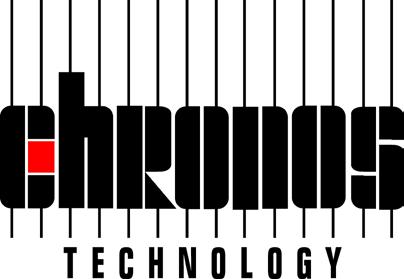
chronos.uk
Chronos Technology is a Master Systems Integrator (MSI) committed to improving the efficiency, security and resilience of healthcare facilities by delivering Real Time Location (RTLS) and Real Time Healthcare (RTHS) to for asset tracking, personnel and patient safety, and the automation of processes to increase efficiency of operations.
CLINISYS
01932 581 200
info-uk@clinisys.com

www.clinisys.com
Clinisys is a global provider of intelligent diagnostic informatics solutions and expertise designed to redefine the modern laboratory, across healthcare, life sciences, and public health. Millions of diagnostic results and data insights are generated every day using Clinisys’ platform and cloud-based solutions in over 3,000 laboratories across 34 countries.










100% ELECTRIC ADAPTIVE AND VERSATILE ELECTRIC UTILITY VEHICLES FOR SUSTAINABLE, ENVIRONMENTAL, AND COST-EFFECTIVE WASTE COLLECTION AND STREET CLEANING

0ZERO-EMISSIONS


